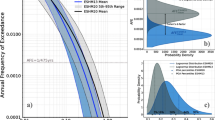Abstract.
—A new methodology for probabilistic seismic hazard analysis is described. The approach combines the best features of the "deductive" (Cornell, 1968) and "historic" (Veneziano et al., 1984) procedures. It can be called a "parametric-historic" procedure. The maximum regional magnitude m max is of paramount importance in this approach and Part I of the authors’ work (Kijko and Graham, 1998) was dedicated to developing efficient statistical procedures that can be used for the evaluation of this parameter. In Part II the approach of a probabilistic seismic hazard assessment at a given site is described. The approach permits the utilization of incomplete earthquake catalogues. It is assumed that a typical catalogue contains two types of information historical macroseismic events that occurred over a period of a few hundred years and recent, instrumental data. The historical part of the catalogue contains only the strongest events, whereas the complete part can be divided into several subcatalogues, each assumed complete above a specified threshold of magnitude. The author’s approach also takes into account uncertainty in the determination of the earthquake magnitude. The technique has been developed specifically for the estimation of seismic hazard at individual sites, without the subjective judgment involved in the definition of seismic source zones, in which specific active faults have not been mapped and identified, and where the causes of seismicity are not well understood. As an example of the application of the new technique, the results of a typical hazard analysis for a hypothetical engineering structure located in the territory of South Africa are presented. It was assumed that the only reliable information in the assessment of the seismic hazard parameters in the vicinity of the selected site comes from a knowledge of past seismicity. The procedure was applied to seismic data that were divided into an incomplete part, containing only the largest events, and two complete parts, containing information obtained from instruments. The simulation experiments described in Part I of our study have shown that the Bayesian estimator K-S-B tends to perform very well, especially in the presence of inevitable deviations from the simple Gutenberg–Richter model. In the light of this fact value m^max = 6.66 ± 0.44, which was obtained from the K-S-B technique, was regarded as the best choice. At an exceedance probability of 10−3 per annum, the median value of peak ground acceleration on rock at the site is 0.31g, and at an exceedance probability of 10−4 per annum, the median peak ground acceleration at the site is 0.39g. The median value of the maximum possible acceleration at the site is 0.40g, which was calculated from attenuation formulae by assuming the occurrence of the strongest possible earthquake, e.g., with magnitude m^max = 6.66 at distance 10 km.
Similar content being viewed by others
Author information
Authors and Affiliations
Additional information
Received April 21, 1998, accepted September 10, 1998.
Rights and permissions
About this article
Cite this article
Kijko, A., Graham, G. "Parametric-historic" Procedure for Probabilistic Seismic Hazard Analysis Part II: Assessment of Seismic Hazard at Specified Site. Pure appl. geophys. 154, 1–22 (1999). https://doi.org/10.1007/s000240050218
Issue Date:
DOI: https://doi.org/10.1007/s000240050218




